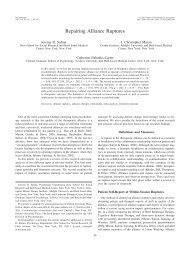Download - The Safran Lab
Download - The Safran Lab
Download - The Safran Lab
Create successful ePaper yourself
Turn your PDF publications into a flip-book with our unique Google optimized e-Paper software.
Luborsky identifies two types of "helping alliance": Type 1 characterizes the early stages<br />
of therapy and is more evident in the beginning stages of treatment. Type 2 emerges later<br />
in treatment and essentially is more responsive to changes in the therapeutic process.<br />
In 1979, Edward Bordin proposed a broader definition of the working alliance, one<br />
that would lead to the development of a transtheoretical construct. Bordin suggests that<br />
the alliance is primarily a conscious "here-and-now" relationship that is generic to all<br />
helping processes. Bordin's transtheoretical definition of the alliance is made up of three<br />
interlocking components: bonds, tasks, and goals. <strong>The</strong>se components are theorized to<br />
facilitate therapy and are beneficial therapeutic agents in their own right.<br />
Briefly, "tasks" refer to the behaviors that inform the therapeutic process. In an<br />
effective treatment both patient and therapist must perceive these tasks as efficacious and<br />
important and both must agree to perform them. "Goals" refer to the patient and<br />
therapist's perception of outcome. A positive alliance is characterized by the therapist's<br />
and the patient's mutual agreement and valuing of the goals of the treatment. Finally, the<br />
concept of "bonds" includes issues of mutual trust, acceptance, positive personal<br />
attachment and confidence. <strong>The</strong> quality of the alliance is a function of the degree to<br />
which the patient and therapist are able to negotiate an agreement about the tasks and<br />
goals in the therapy and this, in turn, mediates the quality of the bond.<br />
Bordin's conceptualization of the alliance placed emphasis on the interdependent<br />
relationship between the specific technical aspects of therapy and the non-specific,<br />
therapeutic effects. Furthermore, Bordin suggested that the quality of the alliance is<br />
mediated by this complex, multidimensional, and interdependent relationship.<br />
7



